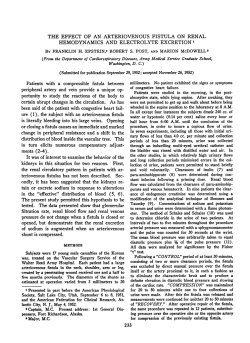
The anomalous clinical anatomy of congenital
Journal of Pediatric Surgery (2011) 46, 1593–1602 www.elsevier.com/locate/jpedsurg The anomalous clinical anatomy of congenital pouch colon in girls Rajiv Chadha ⁎, Subhasis Roy Choudhury, Nitin Pant, Vishesh Jain, Archana Puri, Himanshu Acharya, Noor Ullah Zargar, Anjani Kumar Kundal The Department of Pediatric Surgery, Lady Hardinge Medical College and Kalawati Saran Children's Hospital, New Delhi 110001, India Received 26 September 2010; revised 11 December 2010; accepted 12 January 2011 Key words: Anorectal malformation; Cloaca; Pouch colon, congenital; Uterus didelphys; Septate vagina; Urinary incontinence Abstract Background/Purpose: The aim of this study was to evaluate the anomalous clinical anatomy of congenital pouch colon (CPC) associated with anorectal agenesis in 22 consecutive girls managed over a study period of 7 years. Methods: The 22 patients were categorized into 2 groups. Group A consisted of 10 patients who presented during the neonatal period (n = 9) or as a young infant (n = 1). In these patients, only preliminary assessment results were available. Group B (12 patients) comprised 5 newborns who remained on followup and 7 patients who presented after the age of 1 year. These 12 patients were assessed and investigated in more detail. Results: In group A patients, apart from absence of the normal anal opening, the appearance of the external genitalia and perineum was essentially normal. Retraction of the labial folds showed radiation of folds inward from the margins of the vulval vestibule toward the center, at a point of confluence located at a higher level. At laparotomy, the subtypes of CPC were type I (n = 4), type II (n = 5), and type III (n = 1). In 8 patients, uterus didelphys was present. In all group B patients, the appearance of the external genitalia was similar to that in group A patients. However, separate openings of the urethra, septate vagina, and vestibular fistula (if present) were visible in 5 patients, whereas in 3 patients, a single perineal opening was identified. A total of 9/12 patients (75%) had urinary incontinence. Examination under anesthesia and endoscopy revealed a septate vagina in all 12 patients and an open, incompetent bladder neck with reduced bladder capacity in the 9 patients with urinary incontinence. The terminal fistula of the colonic pouch opened just distal to the bladder neck (n = 1), just posterior and cephalad to the urethral opening (n = 2), low in the vestibule (n = 5), and undetermined (n = 4). The subtypes of CPC were type I CPC (n = 2), type II CPC (n = 9), and type III CPC (n = 1). All 12 patients had uterus didelphys. Conclusions: The characteristics in the anomalous clinical anatomy of CPC in girls, as described here, appear to be almost invariable and, especially in regions where CPC is common, should alert the clinician to the presence of this malformation. © 2011 Elsevier Inc. All rights reserved. ⁎ Corresponding author. G-123 Vikaspuri, New Delhi 110018, India. Tel.: +91 011 28547640, +91 09312226036 (M). E-mail address: [email protected] (R. Chadha). 0022-3468/$ – see front matter © 2011 Elsevier Inc. All rights reserved. doi:10.1016/j.jpedsurg.2011.01.013 1594 Congenital pouch colon (CPC) is an unusual abnormality in which a pouchlike dilatation of a shortened colon is associated with an anorectal malformation (ARM). This malformation has most frequently been reported from centers in northern India [1-9] where it is fairly common, comprising 4.38% [1] to 18.7% [9] of all ARM. The condition is less common in girls, the male to female ratio in large series ranging from 2.25:1 [7] to 7:1 [8]. In boys with CPC, the colonic pouch almost invariably ends in a colovesical fistula [3,5-7]. However, in female patients, the anatomy of the anomaly is more variable, perhaps because of the additional role played by the Müllerian duct system in the development of the internal genital organs, lower urinary tract, and the external genitalia [10]. In addition, a large number of girls with CPC may present for the first time during infancy or childhood if evacuation through the terminal fistula of the colonic pouch is effective [2,4-6,11-13]. This report describes a study of the anomalous clinical anatomy of CPC in 22 girls who presented at our institution with this malformation over a study period of 7 years. In 10 patients, assessment could be performed only during the neonatal period or early infancy. In the remaining 12 patients, belonging to an older age group, a more detailed evaluation and assessment was performed. 1. Material and methods During the period from January 2003 to December 2009, 22 girls with CPC associated with an ARM were managed by the Department of Pediatric Surgery, Lady Hardinge Medical College and Kalawati Saran Children's Hospital, New Delhi. A detailed record of the patients was maintained and forms the basis for this study. The 22 patients were categorized into 2 groups. The first group (group A) consisted of 10 patients who presented during the neonatal period (n = 9) or as a young infant (n = 1) and underwent clinical assessment, investigations, and primary surgery at this stage. Subsequently, these patients were lost to follow-up, and therefore, only the results of preliminary assessment and operative findings were available (Table 1). The second group (group B) of 12 patients comprised 7 patients who presented after the age of 1 year and were investigated in more detail, especially regarding the status of the urinary tract, including examination of the external genitalia and perineum under anesthesia (EUA) and endoscopic examination of the lower genitourinary tract (Table 2). This group also included 5 patients who had presented initially in the neonatal period, undergone preliminary management, and remained on follow-up for further investigations and treatment. Their age at assessment for this study is shown in Table 2. Preliminary surgery in these 5 patients had consisted of excision of the colonic pouch after ligation of the terminal fistula as low down as possible in 4 patients (cases 35 and 8) and ligation of the fistula, subtotal excision of the pouch with tubularization of its remaining portion, and an end R. Chadha et al. Table 1 Newborns and infant girls with CPC (n = 10) Age Clinical examination 1. Typical CPC appearance external genitalia 2. Gross abdominal distension 3. Stigmata of pseudoexstrophy Radiologic findings 1. Invertogram/plain x-ray abdomen (n = 8) 2. X-ray sacrum (n = 8) Operative findings 1. Subtype of CPC 2. Distension of colonic pouch 3. Appendiceal abnormalities 4. Internal genitalia NB-20d (n = 9), 4 mo (n = 1) 10 (100%) 3 (all NB) (30%) 1 (10%) Large AFL (4); smaller AFL (1); no AFL (n = 3) Normal (6); partial sacral agenesis (2) Type I (4); type II (5); type III (1) Moderate (3); severe (7) Double appendix (4; type II, 3; type III, 1); absent appendix (4; type I, 3; type II, 1) Double Ut., V (8); NE (2) NB indicates newborn; AFL, air-fluid level; Ut., uterus; V, vagina; NE, not examined. colostomy in one girl (case 10). The protocol for radiologic assessment consisted of x-rays of the sacrum, an abdominal ultrasound (US), and a micturating cystourethrogram (MCU). However, because of logistic reasons, MCU could be attempted in only 6 patients. In 3 patients, an intravenous urogram (IVU) had been performed elsewhere, before referral to our center. Based on operative findings, patients in both groups were categorized into the 4 subtypes of CPC as described by Narasimharao et al [3], namely: Type I: normal colon is absent and the ileum opens directly into the colonic pouch Type II: the ileum opens into a short segment of cecum, which then opens into the colonic pouch Type III: presence of a significant length of normal colon (7-8 cm in the newborn) between the ileum and the colonic pouch, and Type IV: presence of near normal colon with only the terminal portion (rectum and a varying length of the sigmoid colon) being converted into the colonic pouch. 2. Results 2.1. Group A The important findings in patients belonging to group A are shown in Table 1. All the patients had absence of the anal opening at its normal site. One patient, with gross abdominal Older girls with CPC (n = 12) Patient characteristics Clinical examination Radiology EUA and endoscopy Case no. External genitalia Urinary incontinence US KUB MCU Position of urethral opening Bladder neck Location of fistula Bladder capacity CPC subtype Double Ut., V SPO —– N —– High N Behind urethral meatus, ant. to vagina (high VF) Proximal urethra Not seen VF Not seen VF VF Not seen VF Not seen Behind urethral meatus, ant. to vagina (high VF) VF N II + N NE ↓↓ ↓↓ ↓↓ ↓↓ ↓ ↓ ↓ ↓↓ I II II II II II I III II II + + + + + + + + + + ↓↓ II + Age (y) 1 3 2 3 4 5 6 7 8 9 10 11 2 1.5 2 2.5 10 3 2 1.5 14 5 Ur. Sept. V SPO Typ. CPC app. SPO Ur. Sept. V, VF Typ. CPC app. Typ. CPC app. Ur. Sept. V, VF Ur. Sept. V Typ. CPC app. —– —– CUI CUI CUI CUI PUI CUI PUI PUI N N N N N N N N N N —– —– Uns. —– Uns. BNI BNI, Bl. cap. ↓↓ BNI, Bl. cap. ↓ N —– Low High High High High High High High Low High N NE BNI-severe BNI-severe BNI-severe BNI-severe BNI-partial BNI-partial BNI-partial BNI-partial 12 1 Ur. Sept. V, VF CUI N —– Low BNI-severe Operative findings Clinical anatomy of congenital pouch colon in girls Table 2 SPO indicates single perineal opening; Ur. Sept. V, urethral opening with septate vagina; Typ. CPC app., typical CPC appearance; N, normal; BNI, bladder neck incompetent; VF, vestibular fistula; KUB, kidneys and urinary bladder; ant., anterior; Uns., unsatisfactory; Bl. Cap., bladder capacity. 1595 distension, had edema of the perineum and vulva with clinical evidence of systemic sepsis. Continuous dribbling of urine was noted in 1 newborn. On clinical examination, all 10 patients had a very characteristic and typical appearance of the external genitalia, as shown in Fig. 1. At first sight, apart from absence of the anal opening at its normal site, without retraction of the labia, the appearance of the external Fig. 1 Appearance of the external genitalia in 2 newborns with CPC. The vestibule is wide with folds from its margins radiating inward and upward. B, the folds appear to meet at a higher level. 1596 R. Chadha et al. 2.2. Group B Fig. 2 Photograph taken during surgery in a newborn with type II CPC showing the dilated colonic pouch (arrow), uterus didelphys with both uterii distended with gas and meconium (arrowheads), and the normal proximal colon. Table 2 summarizes the important findings in the 12 girls belonging to group B. In all 12 patients, on initial examination in the outpatient clinic, the essentially normal appearance of the external genitalia was similar to that seen in group A patients. However, in 5 patients, the openings of the urethra, septate vagina, and vestibular fistula (if present) could be identified on mild to moderate retraction of the labial folds (Fig. 3), whereas in 3 patients, only a single, but wide, perineal opening was visible (Fig. 4). Nine (75%) of the 12 patients had urinary incontinence (UI), which was partial in 3 girls and complete in 6 others. The girls with partial urinary incontinence (PUI) were passing urine in a stream at regular intervals but had diurnal and nocturnal dribbling. Extensive perineal and perivulval excoriations owing to UI were present in 5 of the 6 girls with complete urinary incontinence (CUI) (Fig. 3-B), whereas a mild degree genitalia and perineum was essentially normal without any of the features characteristic of cloacal malformations. Retraction of the labia majora showed radiation of folds inward from the margins of the vulval vestibule toward the center, at a point of confluence located cranially at a higher level (Fig. 1). In one girl, the openings of the double vaginas could be seen lowdown in the vestibule after moderate retraction of the labial folds. In the other 9 patients, it was not possible to separately identify the urethral or vaginal orifices or the opening of the terminal fistula of the colonic pouch. Perineal excoriations were seen in 1 girl. One girl had features of pseudoexstrophy with a low-set umbilicus, widely separated pubic ramii, and scarring of the lower abdominal wall. Abdominal x-ray/invertogram showed a large air-fluid level characteristic of type I/II CPC [3,5-7] in 4 patients, whereas this feature was absent in 3 patients, probably because of decompression of the pouch through the associated fistula. In 1 girl with a type III anomaly, a relatively smaller air-fluid level was seen. Laparotomy revealed that 8 patients had uterus didelphys with one hemiuterus and vagina flanking the distal part of the colonic pouch on each side (Fig. 2). In 3 of these 8 patients, all of whom had presented with gross abdominal distension, the fallopian tubes, uterii, and vaginas were grossly distended with gas and meconium (Fig. 2), with, in addition, the urinary bladder being thick walled in 1 child. Although the colonic pouch narrowed distally toward the pelvis, it was still quite wide at the level of the peritoneal reflexion (Fig. 2), and the exact level of termination of the colonic pouch could not be made out in any patient. Appendiceal abnormalities were common (Table 1). In 2 patients, the general condition was poor, and during construction of a window colostomy in one girl and a proximal loop ileostomy with decompression of the pouch in the other girl, no attempt was made to study the anatomy of the internal genitalia. Fig. 3 Low defects. Light retraction of the labial folds showing case 2 (A), the urethral and vaginal openings, and case 9 (B), the urethral and vaginal openings, and the vestibular opening of the fistula. Note excoriations owing to complete urinary incontinence. Clinical anatomy of congenital pouch colon in girls 1597 Fig. 5 (Case 4) MCU showing a widely open, patulous bladder neck and a bladder of very small capacity in a girl with CUI. Fig. 4 (Case 1) Retraction of the labial folds in the outpatient clinic (A), showing only a single but wide perineal opening, and during EUA (B), showing a high defect with a septate vagina. A transurethral catheter is draining the urinary bladder. of perineal excoriation was seen in one girl with PUI. One 14year-old girl (case 10) had had a normal puberty and was having normal menstrual periods. In all 12 patients, biochemical renal function tests were normal. X-rays of the sacrum were normal in 11 patients, whereas in one patient (case 12), the films were not available for assessment. An MCU, attempted in 6 patients, was unsuccessful in 2 patients as the dye could not be retained because of an incompetent bladder neck (Fig. 5). Intravenous urogram, performed in 3 patients, was normal in 1 girl (case 4), although filling of the vaginas was noted after the child micturated. In another girl (case 9), mild bilateral hydroureteronephrosis was present, whereas in the third patient (case 10), the IVU was normal apart from a unilateral bifid renal pelvis. The EUA and endoscopic examination confirmed the presence of a septate/double vagina in all 12 patients. The position of the urethral opening and, thus, the meeting point (confluence) of the urethral and vaginal openings in the vestibule were classified as being “low” or near normal (b1.5 cm from the base of the clitoris) or “high” (N1.5 cm from the base of the clitoris) (Table 2) (Figs. 3,4,6,7). As expected, cases where the confluence was high were those where, in the outpatient department, the anatomy of the external genitalia was not clear and only the typical CPC appearance had been seen. Especially in cases where the confluence was quite high, the vaginal openings seemed to be tilted with the anterior ends meeting at the confluence medially at a higher or more cranial level and the posterior Fig. 6 (Case 11) The high vestibular opening of the fistula (arrowhead) is just posterior to and at a slightly higher level than the urethral opening (arrow). Note the wide urethral meatus. Asymmetrical appearance of the openings is owing to asymmetric retraction of the labial folds. 1598 Fig. 7 (Case 8) External genitalia in a girl with type I CPC. Note that the vaginal openings are quite widely apart, especially posteriorly, and the posterior margin of the vestibule is very wide. ends diverging laterally and inferiorly to end closer to the wide posterior margin of the vestibule (Figs. 4 & 7). On clinical examination and/or endoscopy, the urethral meatus appeared to be wider than normal in all 12 patients (Fig. 6). The urethra was short in length (b2-cm long) in the 11 patients in whom cystourethroscopy was performed. In 3 patients (cases 5, 8, and 9), the urethra was very short, b1 cm in length, and all these patients had UI, CUI in cases 5 and 9, and PUI in case 8. However, 2 patients (cases 1 and 3) with a high confluence of openings and a short urethra had normal urinary continence. Cystourethroscopy showed an open or incompetent bladder neck with reduced bladder capacity in all 9 patients with UI (Table 2). In 2 patients with CUI (cases 6 and 7), the bladder neck was very widely open. In 2 girls with PUI, the bladder neck was seen to close partially after withdrawing the examining cystoscope, in one case (case 8), the bladder neck being deficient posteriorly. On EUA and endoscopic examination, the terminal fistulous opening of the colonic pouch could not be identified in 4 patients, all of whom had undergone primary surgery in the neonatal period. In one of these patients (case 3), endoscopy could not be performed because of malfunctioning equipment. In one patient (case 2), the fistula opened into the urethra just distal to the bladder neck. In the remaining 7 patients, the opening of the terminal fistula was just posterior and a little proximal to the urethral opening, anterior to the vaginal orifices in 2 patients (Fig. 6), a position that can be described as high vestibular, whereas 5 patients had a low vestibular fistula. The position of the vestibular fistulae was also unusual in being very anteriorly placed in most cases, quite close to the urethral openings and in relation to the anterior margin of the vaginal openings (Fig. 3-B). In one of the patients operated on earlier in the neonatal period (case 4), at presentation, the typical CPC appearance as seen in the patients of group A was noted, and the child was thought to be continent for urine. At 2 years, CUI was apparent, and EUA and endoscopic examination revealed a short urethra R. Chadha et al. with a patulous bladder neck, a septate vagina, and a vestibular fistula. Interestingly, at surgery during the neonatal period, a type II CPC had been found with what appeared to be a colocloacal fistula, and the child had undergone division ligation of the fistula. The vestibular fistula, therefore, represented the distal remnant of the colonic pouch. In another girl (case 5) too, CUI became apparent only when the child was brought at the age of 2 1/2 years. At laparotomy, all 12 patients (100%) had uterus didelphys with one hemiuterus and vagina flanking the termination of the colonic pouch on each side (Figs. 8 and 9). Varying degrees of distension of the colonic pouch was noted. The appendix was absent in the 2 patients with type I CPC. Duplication of the appendix was present in 4 patients with type II CPC; in 2 of these patients, both appendices were short and stubby. A Meckel diverticulum was present in 1 patient. 3. Discussion The present study showed that although essentially the anatomy of the malformation was similar in all the patients, there was a spectrum of severity of defects. In newborns, initial examination revealed a fairly wide vulval vestibule, and retraction of the labia majora showed radiation of folds inward from the margins of the vestibule toward the center, at a point of confluence located at a higher level. In older patients, more details were apparent on clinical examination/ EUA and on endoscopy, the terminal fistula of the colonic pouch opening into the urethra or in the vestibule at a high or a low level (Fig. 9 ). All patients had uterus didelphys with a double vagina. Patients in whom the position of the urethral opening, and thus the confluence of the urethral and vaginal openings in the vestibule, was relatively high can well be Fig. 8 (Case 7) Operative photograph showing uterus didelphys with one hemiuterus and vagina flanking the colonic pouch on either side. Clinical anatomy of congenital pouch colon in girls 1599 Fig. 9 Diagrammatic representation of the anatomy in a girl with type II CPC showing the various positions of the terminal fistula of the colonic pouch: urethral, low vestibular, and high vestibular. termed as having a persistent cloaca. However, this may not be entirely correct because, unlike cloacal malformations, in CPC, the appearance of the clitoris, labial folds, vulval vestibule, and the perineum is essentially normal. In addition, during EUA in older girls, probably because of the wide vestibule, even with a high defect, light to moderate retraction of the labial folds can usually, clearly show the separate vaginal openings and, often, the urethral meatus. There are few detailed reports in the literature describing the anomalous clinical anatomy of CPC in female patients. As in boys, and similar to our findings, the CPC subtypes I and II appear to be more common than the subtypes III and IV [2-6,13]. In most cases, the colonic pouch has been reported to terminate in a fistulous communication with either the vagina or a persistent cloaca [1-6,8,9,11-19]. In other reports, the colonic pouch has been described as ending in a vestibular fistula [2,6,9,10,12,16,18,20], a colovesical fistula [2,6,7,9,10,13,14,21], or, as in one case, a perineal fistula [22]. Mathur et al [9] reported that 16 of 27 girls with CPC had a colouterine fistula. There are several reports of girls with CPC having a septate vagina and/or a double uterus and vagina (uterus didelphys) [1,3,5,6,8,10, 13,14,16,20,21,23,24]. The presence of a bicornuate uterus has also been reported [3,6,13,14,16,17]. There are some reports in the literature of girls with CPC in whom the abnormal anatomy was very similar to that described in the present study [1,10,14,20,23,24]. In an earlier study reported from our center [10], 5 girls, not included in the present study, had type I/II CPC with findings virtually identical to those reported here. In 2 patients, the colonic pouch ended in a colovestibular fistula and, in 3 others, in a colovesical fistula. However, detailed assessment of the genitourinary tract, including endoscopic examination, was not performed in any patient. One additional patient had type I CPC, a colovesical fistula, and a persistent urogenital sinus, the uterus and vagina being single. Trusler et al [14] reported a newborn girl, admitted with electrolyte imbalance, who had type II CPC with a colovaginal fistula, which was ligated at laparotomy. Autopsy revealed a double uterus and vagina with the vaginas entering a short “cloacal chamber,” and, posteriorly, a short tubular structure opening in the vestibule. Similar to the findings in one of our cases (case 4), this structure probably represented the distal remnant of the vestibular fistula, which had erroneously been ligated higher up. Sarin et al [13] reported 8 girls with CPC and a persistent cloaca in 2 of whom the cloacal opening had a characteristic “clover-leaf” appearance, similar to the appearance of the external genitalia in newborns as described by us. In 4 patients, the cloaca was short (approximately 5-mm long) and led to closely approximated orifices of the hypospadic urethra and vagina(s). Gharpure [24] reported a child with type I CPC, double uterus and vagina, a colovestibular fistula, and bladder hypoplasia with CUI. One of the 2 girls reported by Demirogullari et al [23] had type I CPC and what appeared to be a colovesical fistula, which was ligated just above the peritoneal reflexion. Examination when the girl was 14-years old revealed CUI, external genital appearance similar to that reported here, and a 7-cm-long 1600 blind-ending tubular structure opening into the vestibule between the vaginas. This structure probably represented the distal remnant of the fistula ligated during the previous surgery. Cystoscopy showed a small hypocompliant urinary bladder. The second patient, a 2 1/2–year-old girl with type II CPC, also had a septate vagina, recessed urinary meatus, a vestibular fistula, and UI. Similar to our findings, in both patients, the sacrum was normal. Although the present study suggests that the abnormal clinical anatomy in girls with CPC, as described by us, is almost invariable, apart from the few exceptions detailed above, other reports, including earlier ones from our center [5,7], have not consistently described these findings. A likely reason is that in newborns and small infants, the anatomy of the external genitalia and perineum is not clear on clinical examination, and endoscopic examination of the genitourinary tract is usually not feasible. Even in older girls, light retraction of the labial folds may only show the folds from the margins of the vulval vestibule radiating upward, the so-called clover-leaf deformity [13], which would usually lead to the diagnosis of a persistent cloaca. The vast majority of reports, including large series [2,37,9,10], have recorded only the findings at primary surgery, usually in the newborn, and not the results of any detailed examination, endoscopy, and/or investigations performed later. As shown by our study as well as other reports [14,23], determining the level of termination of the colonic pouch and associated fistula based on the laparotomy findings during the primary surgery may be fallacious because the dilated pouch narrows down gradually toward the pelvis but is fairly broad even at the level of the peritoneal reflection. The gross appearance may erroneously suggest that the colonic pouch is opening into a cloacal chamber, the urinary bladder, or the vagina. The UI can also be missed in the neonatal period and at laparotomy, unless specifically looked for; the presence of a double uterus and vagina can also easily be missed, especially in newborns with a grossly distended colonic pouch. It is interesting to speculate on the possible embryology of this unusual malformation. According to traditional embryologic doctrine [25,26], the cloaca is partitioned between the 4- (4-week) and the 16-mm (6-week) stage by downward growth of the urorectal or cloacal septum (URS). The classic theories of cloacal partitioning have been challenged by studies, which indicate that ARM result from defective development, to a varying degree, of the dorsal cloaca and/ or cloacal membrane and that there is no evidence that descent of the URS plays any role in the process [27,28]. However, recent research by other workers suggests that some form of descent of the URS and its fusion with the cloacal membrane does occur and that this has an important role to play in differentiation of the cloaca [29-31]. It is likely that very early during cloacal differentiation, the primary event responsible for the occurrence of CPC is “defective organogenesis” of a varying degree of the distal most segment of hindgut close to the descending URS [7,10]. R. Chadha et al. This defective segment could “anchor” the entire cloaca ventrally, preventing further descent of the URS [7,10]. During later development, the abnormal segment of colon would dilate and distend to form the colonic pouch [5,7,10]. The early arrest of cloacal septation accounts for the high and anterior level of the fistulous termination of the colonic pouch in our patients. Even in patients with a vestibular fistula, the fistulous opening was often located quite anteriorly between the anterior margins of the vaginal openings, a position that can more correctly be termed intervaginal. The early error in cloacal septation can also explain the associated abnormalities of the genitourinary tract. During normal development, between the 60- and 110-mm stages, long after cloacal septation is complete, the fused paramesonephric ducts forming the vagina, distally in contact with the Müllerian tubercle, descend toward the perineum [32,33]. This descent, along the anterior surface of the URS, is believed to be responsible for the formation of the dorsal urethra and the closely related trigonal region of the bladder [32-34]. It is because of these relationships that the vagina generally does not extend beyond the termination of the rectum, wherever that may be [33]. In girls with CPC, the descending paramesonephric ducts, kept widely apart by the relatively high communication between the terminal hindgut and the UG sinus, would not be able to fuse leading to uterus didelphys with one hemiuterus and vagina flanking the terminal bowel on each side. Because the ducts do not fuse and remain apart to a varying degree during their descent to the vestibule, the development of the trigone, bladder neck area, and the dorsal portion of the urethra would be affected. This would account for the short urethra in all patients and the varying degree of defective development of the bladder neck with resultant PUI or CUI in 9/12 of our patients. This can also explain the oblique orientation of the openings of the 2 vaginas with a wide posterior margin of the vestibule in several of our patients, including one patient in whom the 2 vaginal openings were very widely apart. The CPC in female patients is also unique because it probably represents the only ARM where the vaginas may be located posterior to the terminal fistula from the hindgut. Interestingly, a severe defect with a high confluence of the urethral and vaginal openings was seen in 3 of our patients, 2 of whom (cases 1 and 3) had normal urinary continence. In 2 other patients, the urethral and vaginal openings were closer to the margins of the vestibule (cases 10 and 12), but UI was present. Thus, the severity of the external anatomical findings and defect does not seem to correlate with whether UI is present. The integrity of the bladder neck, even in the presence of a short urethra, appears to be the main factor responsible for urinary continence. It is also important to realize that as reported earlier [4,7,10] as well as shown by the present study, CPC is very infrequently associated with major malformations in other organ systems including the upper urinary tract. Despite the high nature of ARM associated with CPC, sacral Clinical anatomy of congenital pouch colon in girls abnormalities are rare, and the voluntary musculature of the pelvis and the perineum is well developed [4,7,10]. Thus, the constellation of defects seen in girls with CPC is probably secondary to occurrence of the CPC itself and not owing to a generalized maldevelopment in the cloacal region (cloacal dysgenesis). In this respect, the embryopathogenesis of CPC very likely differs from that of the usual ARM, which are believed to result from defective development of the dorsal part of the cloaca [27,28] and in whom major abnormalities of the caudal developmental area and other major organ systems are common. A noticeable fact is that, in reports from countries other than India, especially those from northern Europe, the anomalous anatomy of CPC appears to be more complex. Dénes et al [35] reported a girl with type I CPC, Down's syndrome, and hydronephrosis. Herman and Coplen [15] reported a girl of Northern European descent who had a type I CPC with persistent cloaca, partial sacral agenesis, widened pubic symphysis, double uterus with absence of one fallopian tube, a duplex left kidney, and a megaureter. Wester et al [16] reported 2 girls, one of whom had type II CPC with cloaca, hemiuterii with short vaginal stumps, partially duplicated urinary bladder, and partial sacral agenesis. The other girl with type II/III CPC had a vestibular fistula with vaginal atresia and 2 isthmus remnants, partial sacral agenesis, and a duplex system draining the left kidney. A similar high incidence of associated major malformations in girls with CPC was reported in 2 studies from Saudi Arabia [18,36]. This would indicate that, unlike in India where, in most cases, CPC and its associated malformations appear to be the consequence of an isolated defect in the development of the terminal bowel during early cloacal differentiation [7], outside India, CPC may occur only as a part of a major constellation of congenital defects. Certain lacunae in the present study, mainly because of problems with logistics and patient compliance, also deserve mention. An IVU should be performed in all patients, because in our study, IVU detected urinary tract abnormalities missed on US examination. In our study, assessment of bladder neck competence, bladder capacity, and pattern of micturition was fairly subjective because it was based on clinical evaluation, MCU, and cystoscopy. Ideally, especially in older girls, a urodynamic assessment should be performed for this purpose. Only one our patients had been followed up till puberty. As shown by a recent study [37], gynecologic anomalies are common in girls with ARM. A longer period of follow-up, well beyond puberty, is, thus, essential for all these patients. In conclusion, the characteristic anatomy of the external genitalia in girls with CPC, such as described here, appears to be almost invariable. This typical appearance, especially in regions such as north India where CPC is common, along with the characteristic radiologic features should alert the clinician to the presence of a CPC malformation. In newborn girls with CPC, if plain x-ray films of the abdomen are not conclusive, US and/or magnetic resonance imaging scan, 1601 such as described in a recent article [38], may help in making a definitive preoperative diagnosis of CPC. In addition, girls with CPC may present for the first time beyond infancy. It is also apparent that in girls with CPC presenting in the neonatal period or early infancy, it would be wise to perform only a proximal diverting ileostomy during primary surgery. Definitive surgery can then be performed when the child is older, after detailed assessment has delineated the exact anatomy of the defect. References [1] Singh A, Singh R, Singh A. Short colon malformation with imperforate anus. Acta Paediatr Scand 1977;66:589-94. [2] Wakhlu AK, Tandon RK, Kalra R. Short colon with anorectal malformation. Indian J Surg 1982;44:621-9. [3] Narasimharao KL, Yadav K, Mitra SK, et al. Congenital short colon with imperforate anus (pouch colon syndrome). Ann Pediatr Surg 1984;1:159-67. [4] Kalani BP, Sogani KC. Short colon associated with anorectal agenesis: treatment by colonorraphy. Ann Pediatr Surg 1984;1:83-5. [5] Chadha R, Bagga D, Malhotra CJ, et al. The embryology and management of congenital pouch colon associated with anorectal agenesis. J Pediatr Surg 1994;29(3):439-46. [6] Wakhlu AK, Wakhlu A, Pandey A, et al. Congenital short colon. World J Surg 1996;20:107-14. [7] Chadha R, Bagga D, Mahajan JK, et al. Congenital pouch colon revisited. J Pediatr Surg 1998;33:1510-5. [8] Gupta DK, Sharma S. Congenital pouch colon. In: Hutson JM, Holschneider AM, editors. Anorectal Malformations. Heidelberg: Springer; 2006. p. 211-22. [9] Mathur P, Saxena AK, Simlot A. Management of congenital pouch colon based on the Saxena-Mathur classification. J Pediatr Surg 2009;44(5):962-6. [10] Chadha R, Gupta S, Mahajan JK, et al. Congenital pouch colon in females. Pedaitr Surg Int 1999;15:336-42. [11] Gopal G. Congenital recto-vaginal fistula with colonic reservoir. Indian J Surg 1989;40:447-9. [12] Ghritlaharey RK, Budhwani KS, Shrivastava DK, et al. Experience with 40 cases of congenital pouch colon. J Indian Assoc Pediatric Surgeons 2007;12(1):13-6. [13] Sarin YK, Nagdeve NG, Sengar M. Congenital pouch colon in female subjects. J Indian Association of Pediatric Surgeons 2007;12(1):17-21. [14] Trusler GA, Mestel AL, Stephens CA. Colon malformation with imperforate anus. Surgery 1959;45:328-34. [15] Herman TE, Coplen D, Skinner M. Congenital short colon with imperforate anus (pouch colon). Report of a case. Pediatr Radiol 2000;30: 243-6. [16] Wester T, Läckgren G, Christofferson R, et al. The congenital pouch colon can be used for vaginal reconstruction by longitudinal splitting. J Pediatr Surg 2006;41:E25-8. [17] Jayapal K. Case report of a rare form of pouch colon with review of the literature. Presented at the 31st Annual Conference of the Indian Association of Pediatric Surgeons, Bangalore, India, October 26th29th; 2005. [18] Pal K. Congenital pouch colon from Al-Ahsa region of Saudi Arabia— A changing demography. 2009. Kuwaiti Med J 2009;4192:39-42. [19] Vaezzadeh K, Gerami S, Kalani P, et al. Congenital short colon with imperforate anus: a definitive surgical cure. J Pediatr Surg 1982;17(2): 198-200. [20] Patil RT, Gupta RK, Sanghvi B, et al. Unusual variants of cloaca—six cases. J Indian Assoc Pediatr Surg 2009;14(3):156. 1602 [21] Boleken ME, Yildiz E, Kaya M, et al. Appendix duplication in association with persistent cloaca and type 2 pouch colon. Int J Anatomical Variations 2010;3:12-4. [22] El Shafie M. Congenital short intestine and cystic dilatation of the colon associated with ectopic anus. J Pediatr Surg 1971;6:76. [23] Demirogullari B, Onur Ozen I, Afsarlar C, et al. Congenital pouch colon associated with anorectal malformation: report of 2 cases. J Pediatr Surg 2007;42:E13-6. [24] Gharpure V. Our experience in congenital pouch colon. J Indian Assoc Pediatr Surg 2007;12(1):22-4. [25] Stephens FD. Embryology of the cloaca and embryogenesis of anorectal malformations. In: Stephens FD, Smith ED, editors. Anorectal Malformations in Children: Update 1988. New York (NY): Liss; 1988. p. 177-209. [26] Gray SW, Skandlakis JE. Embryology for Surgeons. Philadelphia (Pa): Saunders; 1972. p. 187-216. [27] Van der Putte SCJ. Anal and ano-urogenital malformations: a histopathological study of “imperforate anus” with a reconstruction of the pathogenesis. Pediatr Dev Pathol 2006;9:280-96. [28] Paidas CN, Morreale RF, Holoski KM, et al. Septation and differentiation of the embryonic human cloaca. J Pediatr Surg 1999; 34:877-84. [29] Qi BQ, Williams A, Beasley S, et al. Clarification of the process of separation of the cloaca into rectum and urogenital sinus in the rat embryo. J Pediatr Surg 2000;35(12):1810-6. R. Chadha et al. [30] Bai YZ, Chen H, Yuan ZW, et al. Normal and abnormal embryonic development of the anorectum in rats. J Pediatr Surg 2004;39(4): 587-90. [31] Kluth D. Embryology of anorectal malformations. Semin Pediatr Surg 2010;19:201-8. [32] Van der Putte SCJ. Development of the female perineum. In: Van der Putte SCJ, editor. The Development of the Perineum in Humans. Berlin, Heidelberg: Springer-Verlag; 2005. p. 43-63. [33] Allen TD, Husmann DA. Cloacal anomalies and other urorectal septal defects in female patients: a spectrum of anatomical abnormalities. J Urol 1991;145:1034-9. [34] Ramenofsky ML. Vaginal lesions. In: Holder TM, Ashcraft KW, editors. Pediatric Surgery. Philadelphia: WB Saunders Co.; 1980. p. 891. [35] Dénes J, Ziszi K, Bognár M, et al. Congenital short colon associated with imperforate anus (Zachary-Morgan syndrome). Acta Paediatrica Hungarica 1984;25(4):377-83. [36] Al-Salem AH. Unusual variants of congenital pouch colon with anorectal malformations. J Pediatr Surg 2008;43:2096-8. [37] Levitt MA, Bischoff A, Breech L, et al. Rectovestibular fistula—rarely recognized associated gynecologic anomalies. J Pediatr Surg 2009;44: 1261-7. [38] Lopater J, Hery G, Haddad M, et al. Congenital pouch colon: antenatal diagnosis and video-assisted management. Pediatr Surg Int 2010;26: 759-61.
© Copyright 2025


![Download [ PDF ] - journal of evidence based medicine and](http://s2.esdocs.com/store/data/000499809_1-c6b1e3dfacc473ca04f6534c5a5c7150-250x500.png)




